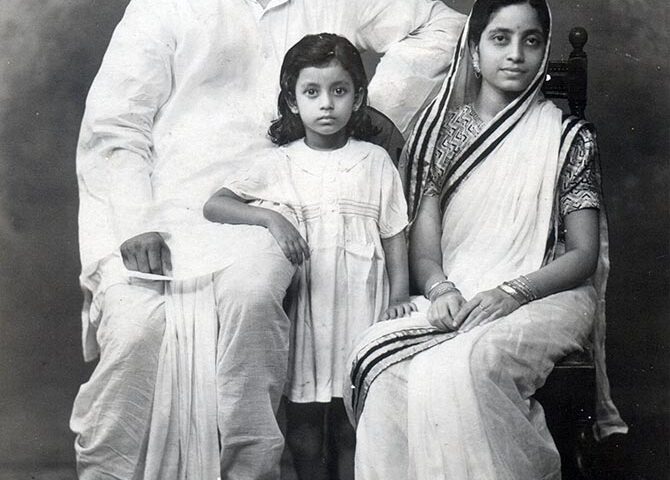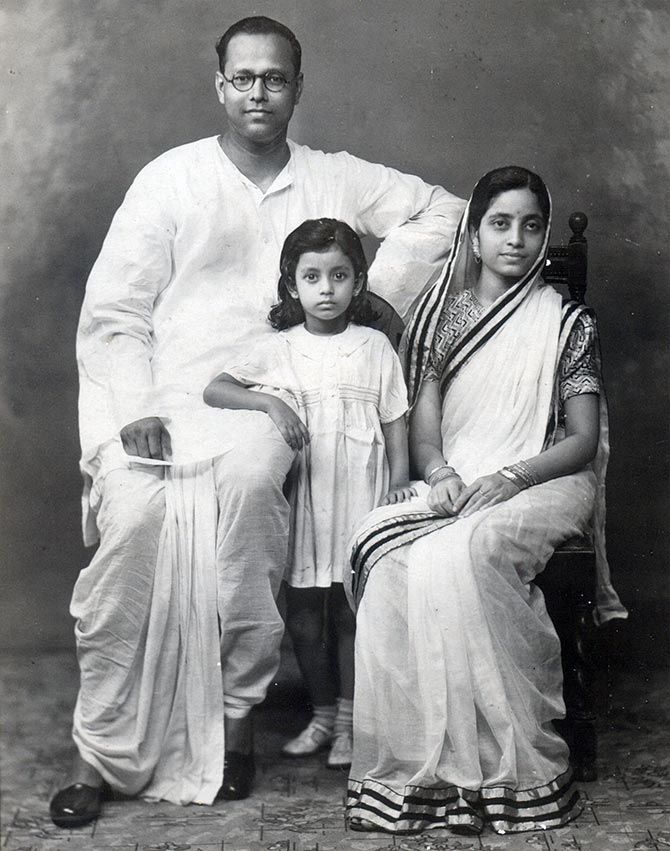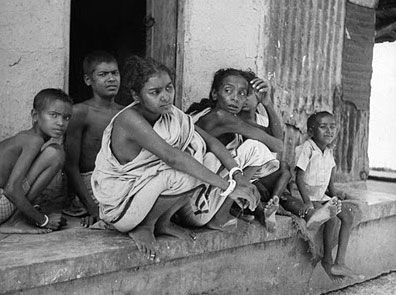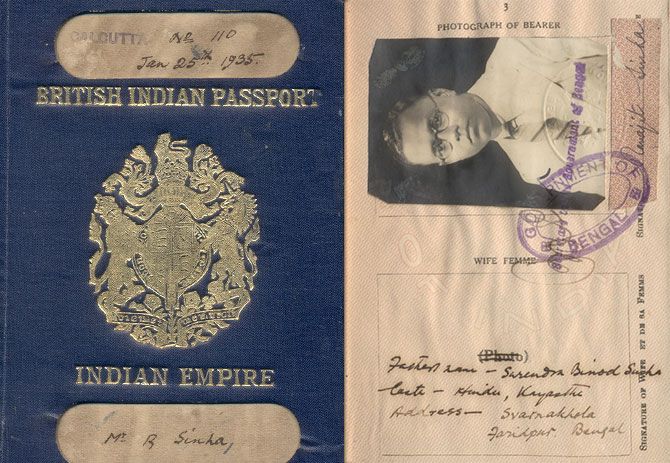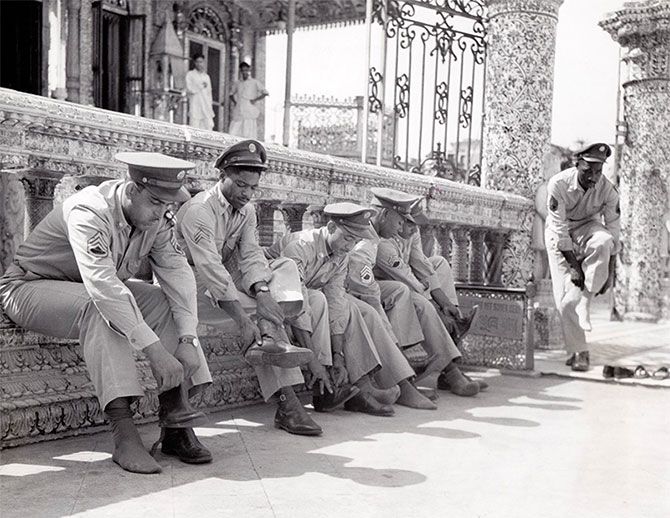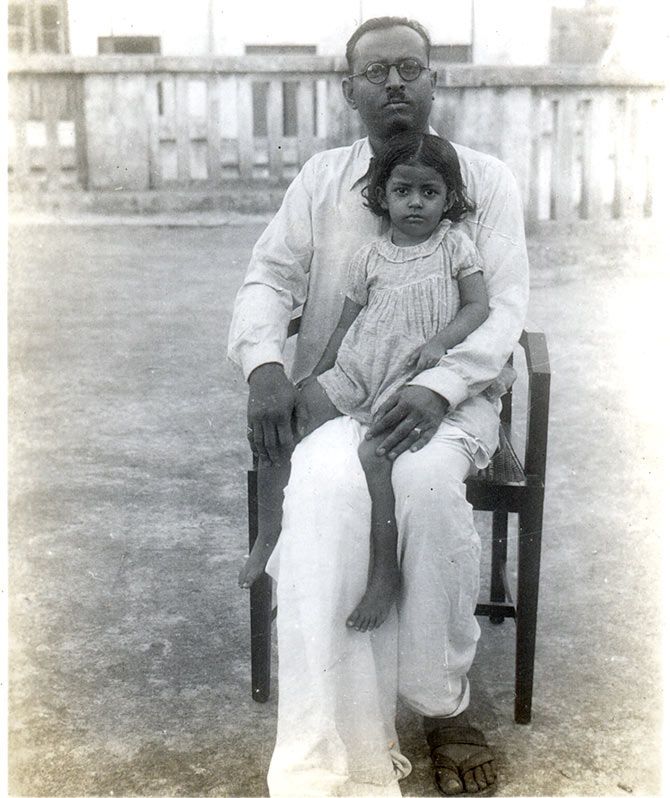As a child in British India, Bharati Dutt lived a privileged and sheltered life in an extended joint family of civil servants, doctors, engineers and Gandhians.
Between the ages of seven and 11, when just old enough to understand, chronicle and remember, she witnessed the life-changing events that shaped a nation still struggling to break out of the shackles of its past and forge a new future.
Mrs Dutt, who passed away early on Sunday morning and would have been 84 today, June 2, 2020, shared her memories — a narrative of India on the threshold of freedom as seen through the eyes of a little girl — with her daughter, Rediff.com‘s Swarupa Dutt.
The Great Bengal Famine of 1943
I don’t know how old he was, maybe my age. I couldn’t see his face since he was lying face down on the footpath.
He was dark, sunburnt, and naked. Emaciated. I wondered why he wasn’t wearing clothes.
My father, a gynaecologist, told me the boy was dead.
We were on our way to his clinic in north Calcutta and the mood in the car was sombre.
At home, conversation among elders was often about the manannatar or famine.
They would talk about people starving to death and lying dead on Kolkata roads, but this was the first time I had actually seen a victim.
We lived in south Calcutta, considered more affluent than many other parts of the city, so we didn’t see any dead bodies lying around. But there were many famine-displaced migrants from rural Bengal begging for food.
Ma, phaan dao… (Mother, give us rice starch water), they would call out.
They never asked for rice, because rice was extremely scarce. Neither did they ask for dal or torkari (vegetables) or maach (fish). Only phaan — the starch — which is normally drained and thrown away when the rice is cooked.
Their plaintive wail for phaan still rings in my ears after all these years.
My mother used to collect the rice starch, add salt to it, and give it to whoever came asking for phaan.
There was a boy, maybe a man, wearing a torn dhoti and a banian. He would often come to the gate of our house asking for phaan.
So I began squirreling rice away from the bharar ghor (larder) and would give it away to him.
My grandaunt caught me at it. First, she scolded me and then explained that it was nearly impossible to get rice and it would be difficult to feed a joint family of 18 and three full-time servants.
At the time, almost nobody in Bengal ate rotis as a staple, so without rice, it was difficult to put food on the plate.
It was only after the war that wheat made a tentative foray into some households.
The quality of rice available during the famine was probably the worst I have ever eaten. But apart from the shortage of rice, we were not really affected.
Children are taught not to waste food, that someone, somewhere, was starving. My parents had to simply point me to the people on the streets.
World War II
In 1943, the Japanese bombed the Kidderpore docks.
Warships of the British army were docked at Kidderpore and bomb after bomb fell on the ships and the warehouses where arms and ammunition were stored.
We could hear it from our house in Ballygunje even though the docks were around 8 to 9 kilometres away.
The sky would light up when the bombs fell in the night.
Air raid sirens would go off regularly. My uncles and the elders in the para (neighbourhood) had been trained by the ARP (Air Raid Patrol) wardens and a trench had been cut a few metres from our home.
My mother’s aunt, who was working in the food department with the government, was an ARP warden.
The moment the sirens went off, we would make a dash for the trenches and stay there till the all-clear was sounded.
The alternative to the trenches was hiding under the stairwell.
The elders in the family — my mother, my grandparents, granduncles and aunts (we were a joint family of 14 members with regular long-duration guests making the count at least 18 at any time) would use the stairwell.
We lived in a two-storeyed house which had 21 French windows on each floor. All the rooms opened into verandahs which encircled the house.
There were two sets of French windows — one with wooden rafters and the other of glass. The responsibility of boarding up those 42 windows and as many glass doors fell upon me and my great grandmother.
Old saris were gummed on to the windows so that in the event of a bomb, the sari would hold the glass shards and not crash on to the ground. My mother would make the gum from a maida paste.
At night, we could turn on only a few of the electric lights because of the air raids, so we used hurricane lanterns. The street lights, which used gas, were not lit.
The Japanese bombed Kolkata for over two years — from 1942 to 1944.
Like thousands of other people in Calcutta, we left for rural Bengal to escape the bombings.
We went to Behrampur and stayed in a rented house. My father and granduncle stayed back in our Calcutta house.
Rationing of food had begun due to the war. Rice, sugar, tea, cloth were all rationed.
We were around 12 people in the Behrampur house. There were no second helpings, not even a second cup of tea.
I remember my grandaunt has asked for another cup of tea, so my mother had to quietly smuggle the sugar from the cupboard and give it to her surreptitiously.
The cloth from the ration shops was called Markin or Long cloth, thick and ugly.
I was the only child there — not a single person in my age group.
Granduncles, grandfathers, grandaunts, aunts and uncles and my parents.
But it was a fun time.
My granduncle, who was a civil surgeon, and my grandfather, who was the postmaster general of the Bengal presidency, were fantastic story-tellers.
He had been awarded the title of ‘Rai Bahadur’ by the British and decades later, my wedding card was in his name, and the title was used though my father had frowned upon it.
So, while we were not rich, we never went wanting.
The Japanese invaded and bombed Burma towards the end of 1941.
My grandaunt and her daughter somehow managed a plane ticket to Calcutta, but my granduncle walked all the way to Calcutta from Rangoon.
His health broke down and he never recovered. He was a civil engineer and they were very well off there. They had to leave everything behind except for a few pieces of jewellery.
I remember she had a beautiful ruby necklace. They reached Calcutta in 1941 and were with us in Behrampur.
We went back to Calcutta after six months, when the bombing slowed down.
On the streets were many American and British soldiers, but they generally kept to themselves.
The area where we stayed had army barracks close by and the Lake Hospital had been requisitioned for use for the armed forces.
In the house behind my maternal grandmother’s lived an elderly woman. She was unmarried.
It was extremely unusual to see single women back then. We learnt later that she had been promised marriage by an American soldier, but he went back home after Independence and never returned.
She slowly started losing her mind. This kind of story was quite common then.
Great Bengal Famine
Some three million Indians died in the famine of 1943, the majority of the deaths were in Bengal.
In the book, Churchill’s Secret War, Madhusree Mukherjee blames Britain’s wartime prime minister Winston Churchill’s policies for being largely responsible for one of the worst famines in India’s history.
The scarcity, she says, was caused by large-scale exports of food from India for use in the war theatres.
The British government was slow to supply humanitarian aid. Churchill when entreated upon to act, said, ‘Famine or no famine, Indians will breed like rabbits.’
When the British government in Delhi sent Churchill a telegram informing him about the horrible devastation and deaths, his response reportedly was, ‘Then why hasn’t Gandhi died yet?’
Japanese bombing of Kidderpore
In December 1942, the Imperial Japanese Army Air Force bombed Calcutta and the city was blacked out from sunset to sunrise.
Aerial attacks on Calcutta continued until December 1944, a few months before the end of the Second World War.
In 1943, the Japanese raid on Calcutta’s Kidderpore docks killed hundreds of people and many ships and warehouses were destroyed.
Calcutta riots
Known as Direct Action Day or the Great Calcutta Killings, 4,000 people lost their lives and over a lakh were left homeless in Calcutta in under 72 hours.
There was widespread rioting and killings between Hindus and Muslims.
The ‘Direct Action’ — August 16, 1946 — was announced by the Muslim League as a show of strength to the British and the Congress to register the Muslim League’s protest against the Congress rejecting the two nation theory.
Muslims feared that if the British pulled out, they would suffer at the hands of the Hindu majority.
This resulted in the worst communal riots in British India.
The violence in Calcutta sparked off rioting in surrounding Noakhali, Bihar, Punjab, and the North Western Frontier Province and sowed the seeds for the eventual Partition of India.
Calcutta riots of 1946
The riots began on August 16, 1946.
Boys from our para would camp on the rooftops of houses armed with bricks and stones.
In the night we would hear cries of ‘Allah Ho Akbar’.
From the roof of our house, you could see flames in the Muslim localities.
Ballygunje was close to Park Circus and Bondel Road, which were both predominantly Muslim areas and there was real fear that our locality would be attacked.
In our house, my granduncle had set up a camp bed on the roof and would stay awake the whole night with a gun.
Hot water and stones were also kept ready on the roof, but thankfully, we never really needed any of it. There were no attacks.
My uncle was stabbed on the way home; the knife had ripped open his shirt, but a Muslim friend he was with saved his life.
There was just one Muslim family in our para — my friend Dolly and her family.
When the riots broke out, the elders in the para (the para was then an extended family) decided to escort them to Park Circus as it was not possible to keep them safe if Hindu mobs attacked them.
I never saw her again.
A relative who used to stay in Park Circus took refuge in our house along with a truckload of people.
At the time, it didn’t matter who the person was, if they wanted refuge, the doors were always open.
But there were practicalities to consider. Roads were unsafe and the markets were shut in the night and there was not enough food in the house for dinner.
So we had a curry of figs from a tree in the garden.
Near my maternal grandmother’s house there was a huge rainwater drain piled high with dead bodies of Muslims. I don’t remember any police on the roads.
The women were taught how to use a knife and a lathi. There were four basic positions in thrust and parry.
For us children, the knives were made of wood.
But I don’t remember there ever being any anti-Muslim sentiment, like there is now, in our family or in our locality, but during the riots, there was fear.
In fact, any discrimination against Muslims was frowned upon and forbidden.
My grandaunt had told us that when Mujibur Rahman (who went on to become Bangladesh’s first president) would visit them, a separate chatai and hookah would be given to him.
My friend Dolly, who was a Muslim, was not allowed to enter some homes, though few. I remember her standing outside, looking crestfallen.
As a child, I never understood why.
Independence Day, 1947
When the date was announced, the first thing we did was practice songs. Deshatto bodhok or patriotic songs of Kazi Nazrul Islam, Rabindranath Tagore and Dwijendralal Roy. My aunts taught us the songs.
The house would reverberate with these songs during practice sessions. It was soul-stirring, emotionally intense.
I was too young to understand the significance of Independence except that it would be the end of British rule, but all the adults at home, relatives, every single person, could speak of nothing else but Independence and the birth of a new Bharatbarsho.
Colloquially, the nation was rarely referred to as India.
A few days before the 15th, my father bought a huge national flag made of Murshidabad silk.
It was the first time we saw the national flag up close.
On the 15th, I wore a white frock with red ribbons in my hair. All my friends were similarly dressed.
At the stroke of the midnight hour, my entire family, friends and many people from the para, went to the roof of our two-storeyed house and the national flag was hoisted by my great-grandmother.
At least 20 of my friends stayed over at our house that night. We barely slept, it was terribly exciting.
We woke up at 4 am, had a bath and went for Prabhat Pheri (morning celebratory procession).
We walked single file singing patriotic songs, carrying the national flag.
We returned home at 7 am and then went to school.
From school we marched to Deshapriya Park (named after the freedom fighter Chittaranjan Das). The whole school was there. We sang songs, listened to speeches and did a mass drill.
In the evening there was a function at our home.
We were the only house which had a radio in the para, so most of the time neighbours would drop in during tea and listen to the radio. It was always open house for everyone.
But that evening, there were more people in the house than I remember.
All the mishti in the house was brought out and everyone simply talked and talked some more.
I remember just watching everyone and soaking in the excitement. I have never felt that way again.
My father headed the Calcutta chapter of the Indian Medical Association, and in that capacity, played host to Sarojini Devi and her husband, who were chief guests at a function.
I was collared to garland them. I wish there were selfies then.
The only other freedom-fighter I have seen was Pandit Nehru. He and Indira Gandhi and I think Padmaja Naidu had come to Calcutta for a Congress meeting at a place called Belgachia in north Calcutta. My aunt took me to the meeting.
There were hundreds of people, but we had arrived early, so went up to the stage and sat in the wings a couple of feet away.
I was more taken in by Indira than Nehru and I remember thinking that she was really very thin.
Conversations at the dinner table in the house was almost always about politics. Heated discussions. My mother always participated. She was extremely politically aware maybe because she came from an enlightened family.
The first woman member of the Bengal assembly was my mother’s aunt.
Dinobandhu Mitra, her uncle, was a dramatist and a playwright, best known for the play Nil Darpan (1860) on the Indigo Revolt. It was based on his experience of indigo cultivators as a post master in Orissa and Bengal.
The play was translated by Michael Madhusudan Dutt and received wide publicity in Europe and was primarily responsible for making the world aware of the ills of indigo farming by the British.
Another relative was Aurobindo Ghosh, the nationalist and freedom-fighter.
So she always encouraged me to listen when politics was discussed, but I didn’t understand the intricacies. Just the excitement.
With freedom came Partition.
We were never personally affected by Partition, because my grandfather had left Faridpur in what is Bangladesh now, in the early 1920s. But the family I was married into was devastated by it.
My father-in-law Pulin Bihari Dutt, a journalist, used to work with The United Press of India in Lahore and handled Karachi, Rawalpindi, Peshawar and Balochistan.
On a holiday to Simla, in the summer of 1947 with his family, India was partitioned.
They could never return home. They lost everything.
My husband had just given his matric exams and the results were posted by a family friend to them in Simla.
He used to tell me that the biggest pain of Partition was never seeing his friends again and never being able to ride his bike.
My father-in-law was a close associate of Netaji Subhas Chandra Bose and was sent to jail several times for seditious writing.
In fact, curiously, both of them looked startling similar he was mistaken for Netaji on several occasions.
My husband’s aunt who had crossed over from Noakhali (now in Bangladesh) lost literally everything. She had just the clothes on her back.
In Calcutta, we did see refugees at Sealdah station. Ill, tired, with all their worldly possessions wrapped in a sari. It was terrible.
There were good memories too like our holidays at my mother’s maternal home in Cooch Behar.
It was a princely state then, part of Bengal, and the late Maharani of Jaipur Gayatri Devi’s maternal home.
Every morning the Cooch Behar palace would blow bugles at the crack of dawn.
A few hours later, Gayatri Devi, accompanied by two other women, would go riding. They would take the path from the palace, past the Sagardighi (a huge lake) and ride by our house.
The moment we heard the clip-clop of hooves, we would run to the gate to see her.
She was beautiful and wore britches and had a riding crop.
Life, pre-1947
Academics: In school we were taught Greek, Roman and British history primarily.
Indian history comprised the Mughals, the 1857 ‘Mutiny’, the history of Bengal (the nawabs and rajas like Chand Rai, Pratap Rai).
The map of India included Pakistan and Bangladesh; it was so beautiful and easy to draw.
Kabuliwallas: There was a legend that they would kidnap children and eat us up.
So we would call out to them from the verandah and then hide.
They used to sell surma, attar, dry fruits and hing.
I would buy surma from them when I was in college. My mother used to buy hing, which was sold as chunks of crystal.
Opium: My granduncle would mix a daub of opium in his milk every night to make him sleep. It was easily available.
Charkha: I wasn’t allowed to spin, but I learnt how to make thread using the device called the tokli from the balls of cotton.
Gas-lit street lamps: Gaslights were used for street lamps before the use of electricity became widespread.
Every evening after dusk a man with a ladder would light the wick of the street lamps. The illumination was mellow.
War surplus:
Shops used to be stocked with Klim milk powder and egg powder, surplus from the British army.
The omelettes turned out much lighter. Parachute cloth in a camouflage print was sold very cheap, but it was highly inflammable.
This feature was first posted on Rediff.com on September 19, 2017.
Source: Read Full Article
